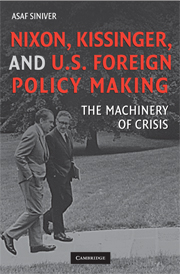Book contents
- Frontmatter
- Contents
- List of Figures
- Acknowledgments
- Abbreviations
- Dramatis Personae
- Nixon, Kissinger, and U.S. Foreign Policy Making
- Introduction
- 1 Structures, Processes, and Personalities in U.S. Foreign Policy
- 2 The Making of U.S. Foreign Policy During the Nixon-Kissinger Years
- 3 The Incursion into Cambodia, Spring 1970
- 4 The Jordanian Crisis, September 1970
- 5 The India-Pakistan War, December 1971
- 6 The Yom Kippur War, October 1973
- Conclusion
- Bibliography
- Index
- Plate section
- References
4 - The Jordanian Crisis, September 1970
Published online by Cambridge University Press: 17 August 2009
- Frontmatter
- Contents
- List of Figures
- Acknowledgments
- Abbreviations
- Dramatis Personae
- Nixon, Kissinger, and U.S. Foreign Policy Making
- Introduction
- 1 Structures, Processes, and Personalities in U.S. Foreign Policy
- 2 The Making of U.S. Foreign Policy During the Nixon-Kissinger Years
- 3 The Incursion into Cambodia, Spring 1970
- 4 The Jordanian Crisis, September 1970
- 5 The India-Pakistan War, December 1971
- 6 The Yom Kippur War, October 1973
- Conclusion
- Bibliography
- Index
- Plate section
- References
Summary
Jordan, a country where you wonder why anybody would ever insure the king. I am sure nobody does.
Off-the-record remark by Nixon, 16 September 1970The decision-making process during the Jordanian crisis is widely considered to be of the highest quality, compared with the management of any other international crisis during the Nixon administration. While the Cambodian crisis was characterised by disorderly procedures, dissenting bureaucracy, and controversial decisions, the WSAG performed remarkably well throughout the Jordanian Crisis and contributed to a smooth decision-making process which consistently produced the ‘best’ policy outcomes at each stage of the crisis.
This high-quality crisis management is even more impressive if one examines the Jordanian Crisis in a more global context. The crisis, which lasted nearly three weeks in September 1970, took place during one of the most challenging periods of Nixon's first term. This ‘autumn of crises’ saw the foreign policy machinery handling almost simultaneously major foreign policy crises in Chile (following the presidential election of Socialist candidate Salvador Allende), in Cuba (the construction of a Soviet naval base in the seaport of Cienfuegos), and in Jordan. Furthermore, this autumn of crises took place only months after U.S. troops pulled out of Cambodia following the controversial incursion. The successful management of the Jordanian Crisis suggests that despite the constraints of a foreign policy system working to its full capacity, and the shadow of a divided nation recovering from a traumatic foreign adventure in Cambodia, the theoretical thrust of the NSC system proved highly effective in coping with multiple foreign policy crises.
- Type
- Chapter
- Information
- Nixon, Kissinger, and US Foreign Policy MakingThe Machinery of Crisis, pp. 115 - 147Publisher: Cambridge University PressPrint publication year: 2008



